Canon Digital Rebel XT: Hardly an Entry-Level DSLR
by Stephen Caston on May 3, 2005 12:05 AM EST- Posted in
- Digital Camera
The Design: Canon EOS 350D
The Canon EOS 350D looks remarkably different than its predecessor, the 300D. In fact, it is so different from the 300D that it makes more sense to compare it to its older and more expensive brother, the Canon 20D. Both cameras have similar sensors, although the sensor in the 350D is slightly smaller. The 20D sensor is 8.2 megapixels and 22.5 mm x 15.0 mm while the 350D sensor is 8.0 megapixels and 22.2 mm x 14.8 mm. The 350D is the smallest digital SLR available from Canon, measuring just 126.5 mm x 94.2 mm x 64 mm. Some other similarities between the 350D and 20D are Canon's DIGIC II image processor, which makes for speedy image processing. Both cameras have remarkable startup times (nearly instantaneous) and incredibly fast transfer speeds from the internal buffer to flash media. Also, both cameras feature an EF-S lens mount that will accept all EF lenses as well as the newer EF-S lenses designed specifically for cameras with a 1.6x crop factor. Perhaps due to popular demand, Canon has implemented 9 Custom Functions into the 350D, which allow the user more extensive control over the camera's operations.On the front of the 350D, we can see the EF-S lens mount that accepts EF as well as EF-S lenses. In the image above, the 350D is shown with the "kit lens", which is an EF-S 18-55mm f/3.5-5.6. The camera can be purchased with this kit lens or separately. On the right side of the front, we can see the lens release button. By pressing this button while rotating the lens, the lens can be detached from the lens mount. On the left side is a circular lamp that acts as the red-eye reduction/self-timer light. It may be hard to see from this angle, but the hand grip on the left side is considerably smaller than it was on the 300D. We will discuss this more in a bit.
As the picture above illustrates, the built-in flash on the 350D rises to a remarkable height. In fact, it is just a bit higher than the flash on the 300D. This should help when attempting to shoot with the flash while using a long lens and/or lens hood.
The layout of the back of the 350D is very similar to the 300D. At the top is the viewfinder that is surrounded in rubber. To the upper-right of the viewfinder is a diopter adjustment knob, which can alter the focus of the viewfinder. Directly below the lens are the LCD panel and 1.8" LCD monitor with 115K pixels. Along the left side are 5 function buttons: Menu, Info., Jump, Play, and Erase. At the upper-right corner of the back are the AE lock/FE lock/Reduce and AF point selection/Enlarge buttons. On the right side of the LCD panel are the Aperture/Exposure compensation button and the Drive mode selection button. On the 300D, the Drive mode selection button was on top of the camera. Below this is the Direct print/LCD panel illumination button. Pressing this button will illuminate the LCD panel with orange light for approximately 6 seconds or until the button is pressed again. To the right of the LCD monitor are the 4-way cross keys with a Set button in the middle. Each arrow button also corresponds to a recording function that can be accessed whenever the camera is on. When a function is selected, the corresponding options screen will appear on the LCD monitor. This is different from the original Rebel (300D) where these options would be selected on the LCD information panel instead. Below are the associated functions:
| Up | ISO |
| Right | Auto Focus |
| Down | White Balance |
| Left | Metering |
To the lower-left of the cross keys is the access lamp, which lights up whenever the camera is reading or writing to removable media.
Starting at the left, we can see the first post for the included neck strap. Directly above the lens is the flash hot-shoe, which accepts Canon's EX-series Speedlite as well as third party flashes. The 350D features Canon's new E-TTL II flash system that is supposed to produce better automatic flash exposures. To the right of the flash hot-shoe is the Mode dial where you can select from 12 different shooting modes. Just like the 300D, the main power switch is located on the right side of the Mode dial. On the top of the hand grip are the Main Dial and shutter button. Finally, the other post for the neck strap is just beside the main power switch. It is a little easier to see the size of the handgrip in this image. Since the camera is relatively thin, you can see that there is not a lot of depth in the handgrip in which to put your fingers. This may be a problem for people with longer fingers or bigger hands.
 |
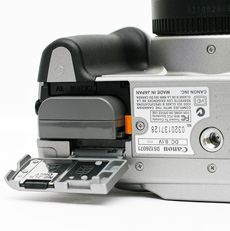 |
| Click to enlarge images. | |
On the bottom of the 350D is the door that conceals the battery compartment. The door can be opened by pressing the release lever. The battery is also secured by an orange clip that must be pushed to the side to release the battery. The 350D uses an NB-2LH Lithium-Ion battery (7.4V 720 mAh) as opposed to the BP-511A used in the 300D. The NB-2LH is physically smaller and has a smaller capacity (65%) than that of the BP-511A. In fact, the NB-2LH is the same battery type used in the Canon PowerShot S60 and S70. Directly below, the lens is the metal tripod mount.
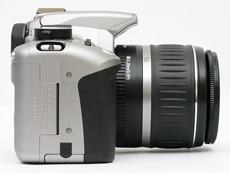 |
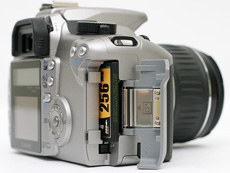 |
| Click to enlarge images. | |
On the right side of the camera is a sliding hinged door that conceals the Compact Flash (Type I or II)/Microdrive media slot. Because it supports FAT32, the 350D supports removable media over 2GB.
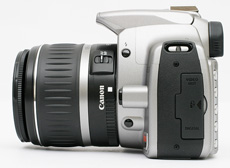 |
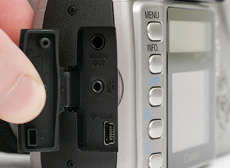 |
| Click to enlarge images. | |
At the upper left is the Flash button. In order to release the flash in any of the advanced recording modes, this button must be pressed. Just below the lens release button is the DOF (depth-of-field) preview button. Normally, when framing an image, the camera will use the largest available aperture to ensure that the photographer can see clearly. By holding down the DOF preview button, the camera will close the aperture (stop down) to the selected value. This gives the photographer an idea of how the image will actually look with the correct DOF. The left side of the camera features 3 connections that are concealed by a rubber fitted tab. The top connection is a video-out port that can be used with the included video cable to view images on a television. The middle port is a remote control terminal that will work with the Remote Switch RS-60E3. Finally, the bottom connection is a USB 2.0 Hi-Speed port.


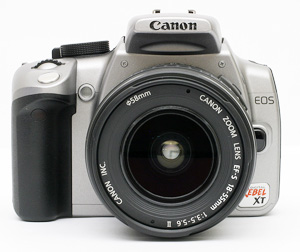
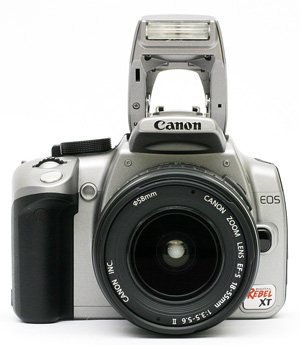
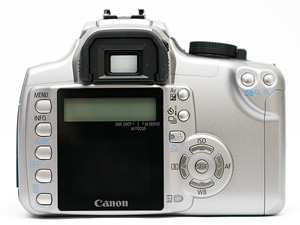
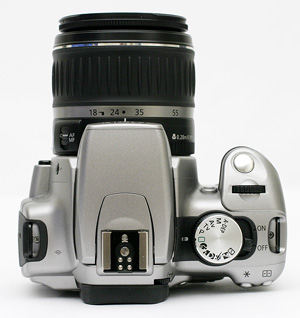








27 Comments
View All Comments
6000SUX - Sunday, May 8, 2005 - link
Thanks for a great review. Based on this one, I went to some other sites like dpreview.com, checked out lots of sample pictures etc. against competitors like the D70 and decided to take the plunge. All I can say is, this camera's fantastic. It's easy even for a relative newbie like me to get up to speed and take really great pictures.Now I have a great camera with which to take pictures of my first child. Thanks again.
stephencaston - Thursday, May 5, 2005 - link
#23, Unfortunately, since the digicam section is still relatively new, we don't have a lot of places to get products right now (lenses). We have been able to do Canon SLR reviews simply because we already have lenses. Don't worry, we are planning on covering the new Nikon DSLRs as soon as we can get them.Stephen
sgtroyer - Thursday, May 5, 2005 - link
I've got to add to the calls for a Nikon DSLR review. It's a pretty glaring omission given the reviews of the Canon 300D, 20D, and 350D, but no Nikon. The D70 is a fantastic camera, far better than the 300D for marginally more money. The D50 will provide even better value. Isn't reviewing only Canon DSLRs sort of like reviewing only Nvidia GPU's or Intel processors?stephencaston - Thursday, May 5, 2005 - link
Keep in mind that this isn't a "real world" battery test. We literally sat down with the camera and took 3,818 frames in one session.Ender78 - Thursday, May 5, 2005 - link
The battery life stated here seems to be a little off. I will have to test, but I dont believe my camera has anywhere close to the stated battery life.gplracer - Wednesday, May 4, 2005 - link
Nice review. I decided on the 20D over the 350 because of the size, feel, and the controls. The wheel in the back of the 20D is so much better than the controls on the 350. I am sure picture quality is close.brownba - Wednesday, May 4, 2005 - link
even my sd300 has this 'rattle.'i too assume it's for determining position.
that's the coolest thing - when you're in clock mode, if you swiftly move the camera, it will change the color of the clock.
shuttleboi - Tuesday, May 3, 2005 - link
From what I've read, the viewfinder on the XT is even smaller than the tiny one I have on my 300D. I also own a Canon film SLR, and the viewfinder in that is freaking huge compared to the one in my 300D. When you have a wide-aperture lens (larger than f2.8), then you will want a large viewfinder to see if you are focusing correctly, otherwise it is very easy to get the focus plane locked with the narrow depth of field.shuttleboi - Tuesday, May 3, 2005 - link
#13: if the XT is like my 300D, then that rattling sound is the part of the camera that determines if you are holding the camera vertically or horizontally. It is normal.STaSh - Tuesday, May 3, 2005 - link
No idea...I have a 20d.